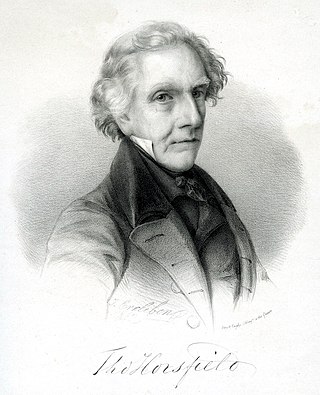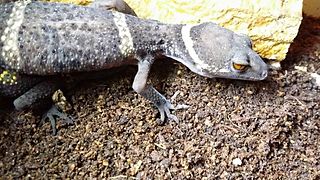
Gekko is a genus of Southeast Asian geckos, commonly known as true geckos or calling geckos, in the family Gekkonidae. Although species such as Gekko gecko are very widespread and common, some species in the same genus have a very small range and are considered rare or endangered.

Ptychozoon was a genus of arboreal geckos, endemic to Southeast Asia, known commonly as flying geckos, gliding geckos, or parachute geckos. They all are now placed in the genus Gekko in the family Gekkonidae. The biogeographic history of the genus Ptychozoon was deeply nested within that of the genus Gekko, the center of diversity of which is within Southeast Asia. Since dispersing into Southeast Asian rainforests, Pytochozoon, like other forest-dwelling vertebrates, adapted to facilitate gliding. All species in the genus Ptychozoon are characterized by cryptic coloration and elaborate webs surrounding the neck, limbs, trunk, and tail. These membranes help to conceal the gecko against trees. When the gecko leaps into the air, the flaps are used to generate lift and allow the gecko to control its fall. It can glide up to 200 feet. Also it does a swoop at the end of its glide to land softly. A similar adaptation is found in geckos of the genus Cosymbotus. There were thirteen described species in the genus Ptychozoon.

Gehyra mutilata, also known commonly as the common four-clawed gecko, Pacific gecko, stump-toed gecko, sugar gecko in Indonesia, tender-skinned house gecko, and butiki in Filipino, is a species of lizard in the family Gekkonidae. The species is native to Southeast Asia. It has made its way to several areas of the world including Sri Lanka, Indochina, and many of the Pacific Islands. Compared to the common house gecko, the appearance of G. mutilata is somewhat plump, with delicate skin. The skin is usually colored a soft purplish/pinkish gray, with golden spots on younger specimens; these spots eventually fade with age.

Thomas Horsfield was an American physician and naturalist who worked extensively in Indonesia, describing numerous species of plants and animals from the region. He was later a curator of the East India Company Museum in London.

Salea horsfieldii, commonly known as Horsfield's spiny lizard or the Nilgiri salea, is a species of lizard in the family Agamidae. The species is endemic to the Nilgiri Hills of India.

The Oriental leaf-toed gecko, also known commonly as the Asian smooth gecko, Bowring's gecko, Bowring's smooth gecko, and the Sikkimese dark-spotted gecko, is a species of lizard in the family Gekkonidae. The species is native to East Asia.

Gekko smithii, commonly known as Smith's green-eyed gecko or the large forest gecko, is a species of lizard in the family Gekkonidae. The species is native to mainland Southeast Asia and Indonesia.

Pseudoxenodon macrops, commonly known as the large-eyed bamboo snake or the big-eyed bamboo snake, is a species of mildly venomous rear-fanged snake endemic to Asia.

Gekko kuhli, commonly known as Kuhl's flying gecko, Kuhl's parachute gecko, or the gliding gecko, is a species of lizard in the family Gekkonidae. The species is found in Southeast Asia.

Gekko lionotum, commonly known as smooth-backed gliding gecko or Burmese flying gecko, is a species of gecko found in Southeast Asia.

Lichtenfelder's gecko is a species of lizard in the family Eublepharidae. The species is endemic to southeastern Asia.
Cnemaspis baueri, also known commonly as Bauer's rock gecko or the Pulau Aur rock gecko, is a species of lizard in the family Gekkonidae. The species is endemic to Malaysia.

Cnemaspis argus, also known commonly as the Argus gecko, the Argus rock gecko, Dring's gecko, and the Lawit Mountain rock gecko, is a species of lizard in the family Gekkonidae. The species is endemic to Peninsular Malaysia.

The Tioman Island rock gecko, also known commonly as the Tioman round-eyed gecko, is a species of gecko, a lizard in the family Gekkonidae. The species is endemic to Malaysia.
The Tenggol Island bent-toed gecko is a species of lizard in the family Gekkonidae. The species is endemic to Tenggol Island in Malaysia.

Cyrtodactylus sworderi, also known commonly as the Johore bow-fingered gecko, the Kota-tinggi forest gecko, and Sworder's bent-toed gecko, is a species of lizard in the family Gekkonidae. The species is endemic to Malaysia.

The Peking gecko is a species of lizard in the family Gekkonidae. The species is endemic to China.
The Siamese green-eyed gecko is a species of lizard in the family Gekkonidae. The species is endemic to Thailand.
Gekko browni, also known commonly as Brown's gecko, Brown's fringe gecko, and Brown's wolf gecko, is a species of lizard in the family Gekkonidae. The species is endemic to West Malaysia.

















